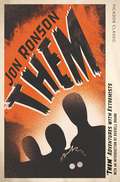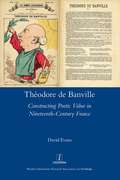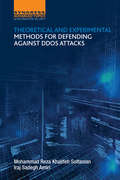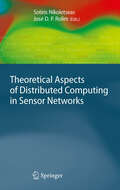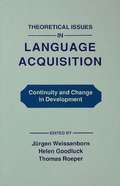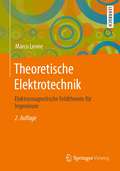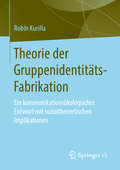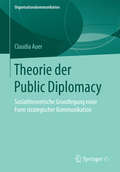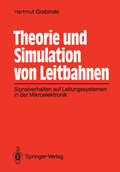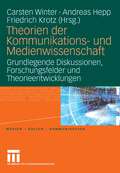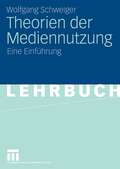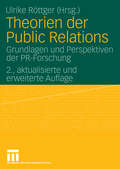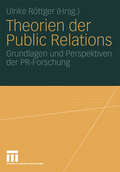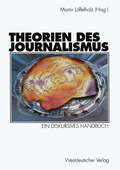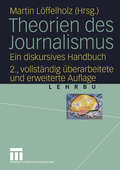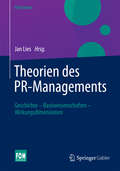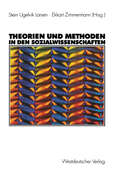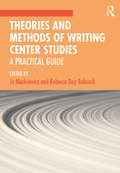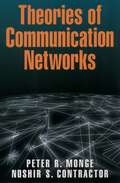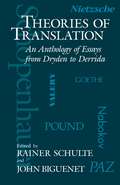- Table View
- List View
Them: Secret Rulers of the World (Picador Classic #18)
by Jon RonsonWith an introduction by Russell BrandWhat if a tiny, shadow elite rule the world from a secret room?My worryingly paradoxical thought process could be summarized thus: Thank God I don't believe in the secret rulers of the world. Imagine what the secret rulers of the world might do to me if I did.What if a tiny, shadow elite rule the world from a secret room? In Them Jon Ronson sets out to find this room, with the help of the extremists - Islamic fundamentalists, neo-Nazis, Ku Klux Klansmen - that believe in it. Along the way, he is chased by men in dark glasses, unmasked as a Jew in the middle of a Jihad training camp, and witnesses international CEOs and politicians participate in a bizarre pagan ritual in the forests of northern California.A Sunday Times bestseller and the book that launched Jon Ronson's inimitable career, Them is an eye-opening, outrageously funny exploration of extremism, which makes both author and reader think twice about the looking-glass world of 'us' and 'them' . . .
Theme Park Project - Schematic and Flowchart (tactile)
by RnibThis diagram shows a schematic and flowchart for a theme park project. Page 1 shows the schematic and page 2 shows the flowchart.
Theodore De Banville: Constructing Poetic Value in Nineteenth-century France
by David EvansTheodore de Banville (1823-1891) was a prolific poet, dramatist, critic and prose fiction writer whose significant contribution to poetic and aesthetic debates in nineteenth-century France has long been overlooked. Despite his profound influence on major writers such as Baudelaire, Rimbaud, Verlaine and Mallarme, Banville polarised critical opinion throughout his fifty-year career. While supporters championed him as a virtuoso of French verse, many critics dismissed his formal pyrotechnics, effervescent rhythms and extravagant rhymes as mere clowning. This book explores how Banville's remarkably coherent body of verse theory and practice, full of provocative energy and mischievous humour, shaped debates about poetic value and how to identify it during a period of aesthetic uncertainty caused by diverse social, economic, political and artistic factors. It features a detailed new reading of Banville's most infamous and misunderstood text, the Petit Traitede poesie francaise, as well as extended analyses of verse collections such as Les Stalactites, Odes funambulesques, Les Exiles, Trente-six Ballades and Rondels, illuminated by wide reference to Banville's plays, fiction and journalism. Evans elucidates not only aesthetic tensions at the heart of nineteenth-century French verse, but also a centuries-old tension between verse mechanisms and an unquantifiable, mysterious and elusive poeticity which emerges as one of the defining narratives of poetic value from the Middle Ages, via the Grands Rhetoriqueurs and Dada, to the experiments of the OuLiPo and beyond.
Theodore De Banville: Constructing Poetic Value in Nineteenth-century France
by David EvansTheodore de Banville (1823-1891) was a prolific poet, dramatist, critic and prose fiction writer whose significant contribution to poetic and aesthetic debates in nineteenth-century France has long been overlooked. Despite his profound influence on major writers such as Baudelaire, Rimbaud, Verlaine and Mallarme, Banville polarised critical opinion throughout his fifty-year career. While supporters championed him as a virtuoso of French verse, many critics dismissed his formal pyrotechnics, effervescent rhythms and extravagant rhymes as mere clowning. This book explores how Banville's remarkably coherent body of verse theory and practice, full of provocative energy and mischievous humour, shaped debates about poetic value and how to identify it during a period of aesthetic uncertainty caused by diverse social, economic, political and artistic factors. It features a detailed new reading of Banville's most infamous and misunderstood text, the Petit Traitede poesie francaise, as well as extended analyses of verse collections such as Les Stalactites, Odes funambulesques, Les Exiles, Trente-six Ballades and Rondels, illuminated by wide reference to Banville's plays, fiction and journalism. Evans elucidates not only aesthetic tensions at the heart of nineteenth-century French verse, but also a centuries-old tension between verse mechanisms and an unquantifiable, mysterious and elusive poeticity which emerges as one of the defining narratives of poetic value from the Middle Ages, via the Grands Rhetoriqueurs and Dada, to the experiments of the OuLiPo and beyond.
Theoretical and Experimental Methods for Defending Against DDoS Attacks
by Iraj Sadegh Amiri Mohammad Reza SoltanianDenial of Service (DoS) attacks are a form of attack that seeks to make a network resource unavailable due to overloading the resource or machine with an overwhelming number of packets, thereby crashing or severely slowing the performance of the resource. Distributed Denial of Service (DDoS) is a large scale DoS attack which is distributed in the Internet. Every computer which has access to the Internet can behave as an attacker. Typically bandwidth depletion can be categorized as either a flood or an amplification attack. Flood attacks can be done by generating ICMP packets or UDP packets in which it can utilize stationary or random variable ports. Smurf and Fraggle attacks are used for amplification attacks. DDoS Smurf attacks are an example of an amplification attack where the attacker sends packets to a network amplifier with the return address spoofed to the victim’s IP address. This book presents new research and methodologies along with a proposed algorithm for prevention of DoS attacks that has been written based on cryptographic concepts such as birthday attacks to estimate the rate of attacks generated and passed along the routers. Consequently, attackers would be identified and prohibited from sending spam traffic to the server which can cause DDoS attacks. Due to the prevalence of DoS attacks, there has been a lot of research conducted on how to detect them and prevent them. The authors of this short format title provide their research results on providing an effective solution to DoS attacks, including introduction of the new algorithm that can be implemented in order to deny DoS attacks.A comprehensive study on the basics of network securityProvides a wide revision on client puzzle theoryAn experimental model to mitigate distributed denial of service (DDoS) attacks
Theoretical Aspects of Distributed Computing in Sensor Networks (Monographs in Theoretical Computer Science. An EATCS Series)
by Sotiris Nikoletseas and José D.P. RolimWireless ad hoc sensor networks has recently become a very active research subject. Achieving efficient, fault-tolerant realizations of very large, highly dynamic, complex, unconventional networks is a real challenge for abstract modelling, algorithmic design and analysis, but a solid foundational and theoretical background seems to be lacking. This book presents high-quality contributions by leading experts worldwide on the key algorithmic and complexity-theoretic aspects of wireless sensor networks. The intended audience includes researchers and graduate students working on sensor networks, and the broader areas of wireless networking and distributed computing, as well as practitioners in the relevant application areas. The book can also serve as a text for advanced courses and seminars.
Theoretical Issues in Language Acquisition: Continuity and Change in Development
by J X00FC Rgen Weissenborn Helen Goodluck Thomas RoeperIn recent linguistic theory, there has been an explosion of detailed studies of language variation. This volume applies such recent analyses to the study of child language, developing new approaches to change and variation in child grammars and revealing both early knowledge in several areas of grammar and a period of extended development in others. Topics dealt with include question formation, "subjectless" sentences, object gaps, rules for missing subject interpretation, passive sentences, rules for pronoun interpretation and argument structure. Leading developmental linguists and psycholinguists show how linguistic theory can help define and inform a theory of the dynamics of language development and its biological basis, meeting the growing need for such studies in programs in linguistics, psychology, and cognitive science.
Theoretical Issues in Language Acquisition: Continuity and Change in Development
by Juergen Weissenborn Helen Goodluck Thomas RoeperIn recent linguistic theory, there has been an explosion of detailed studies of language variation. This volume applies such recent analyses to the study of child language, developing new approaches to change and variation in child grammars and revealing both early knowledge in several areas of grammar and a period of extended development in others. Topics dealt with include question formation, "subjectless" sentences, object gaps, rules for missing subject interpretation, passive sentences, rules for pronoun interpretation and argument structure. Leading developmental linguists and psycholinguists show how linguistic theory can help define and inform a theory of the dynamics of language development and its biological basis, meeting the growing need for such studies in programs in linguistics, psychology, and cognitive science.
Theoretische Elektrotechnik: Elektromagnetische Feldtheorie für Ingenieure
by Marco LeoneAm Anfang des Buches wird die allgemeine Maxwell’sche Theorie elektromagnetischer Felder und ihre Unterteilung für die unterschiedlichen Problemstellungen ausführlich dargestellt. Auf die Verbindung zwischen Feldtheorie und der elektrischen Netzwerke wird ausführlich eingegangen. Der methodische Schwerpunkt liegt in der Aufstellung und Lösung grundlegender Randwertprobleme der Elektro- und Magnetostatik, zeitabhängiger Diffusionsfelder in elektrischen Leitern sowie Wellenfelder im Freiraum, entlang von Leitungen und in Hohlräumen. Dabei wird auf die Einheitlichkeit der übergeordneten Lösungsmethodik besonders Wert gelegt, sodass das einmal Erlernte auf andere Problemstellungen übertragen werden kann. Ausführliche Rechenbeispiele und zusätzliche Übungsaufgaben mit Lösungen dienen zur Vertiefung und Klausurvorbereitung. Die dafür benötigten mathematischen Formeln der Vektoralgebra, Koordinatensysteme und der Vektoranalysis sind in einem Anhang zum Nachschlagen zusammengestellt.
Theorie der Gruppenidentitäts-Fabrikation: Ein kommunikationsökologischer Entwurf mit sozialtheoretischen Implikationen
by Robin KurillaBisher gibt es keine umfassende und kohärente Annäherung an die Bestimmung der an der Konstruktion von Gruppenidentitäten beteiligten kommunikativen und präkommunikativen Prozesse. Die vorliegende Untersuchung schließt diese Lücke durch die Entwicklung einer einheitlichen theoretischen Grundlage, mit der sich empirische Konstruktionsprozesse erfassen lassen. Überdies leistet sie einen Beitrag zur Domäne der Gruppenkommunikationsforschung. Es wird ein grundlagentheoretisches Flussbett geschaffen, das eine begriffliche Fundierung der Konzeption von Inter- und Intragruppenkommunikation liefert, die nicht von ‚objektiven’ Kategorien ihren Ausgang nimmt, sondern von de facto stattfindenden Vergesellschaftungsprozessen. Zudem wird am Beispiel der Gruppenidentitätskonstruktion die Architektur einer innovativen Sozialtheorie vorgestellt, die den Ansprüchen kommunikationswissenschaftlicher und womöglich auch in anderen Disziplinen zu verortender Erkenntnisinteressen genügt.
Theorie der Public Diplomacy: Sozialtheoretische Grundlegung einer Form strategischer Kommunikation (Organisationskommunikation)
by Claudia AuerClaudia Auer entwickelt eine Theorie der Public Diplomacy, die handlungstheoretische Ansätze mit makrosoziologischen Perspektiven zusammenführt. Detailliert analysiert sie einen bislang kaum erforschten Bereich kommunikativen Handelns und zeigt gleichzeitig, dass mit der sozialtheoretischen Grundlegung nicht nur Public Diplomacy, sondern verschiedene Formen strategischer und öffentlicher Kommunikation theoretisch erfasst werden können. Ihre Überlegungen zum Entwurf einer Theorie der PR und des Journalismus lassen erkennen, dass diese auch in solchen Forschungsfeldern zu neuen und weiterführenden Erkenntnissen führen können, die bereits durch Sozialtheorien gut erfasst worden sind.
Theorie und Simulation von Leitbahnen: Signalverhalten auf Leitungssystemen in der Mikroelektronik
by Hartmut GrabinskiTheorien der Kommunikations- und Medienwissenschaft: Grundlegende Diskussionen, Forschungsfelder und Theorieentwicklungen (Medien • Kultur • Kommunikation)
by Carsten Winter Andreas Hepp Friedrich KrotzIn den letzten Jahren hat sich die Auseinandersetzung mit theoretischen Ansätzen innerhalb der Kommunikations- und Medienwissenschaft erheblich intensiviert. Im Fokus steht dabei einerseits die Frage, was die grundlegenden theoretischen Ansätze der Kommunikations- und Medienwissenschaft sind. Andererseits geht es um eine Diskussion der originären Theorieentwicklungen der Kommunikations- und Medienwissenschaft in ihren unterschiedlichen Forschungsfeldern. Das Werk zielt darauf, einen Überblick über diese aktuelle Theoriediskussion zu geben und zukünftige Perspektiven aufzuzeigen.
Theorien der Mediennutzung: Eine Einführung
by Wolfgang SchweigerIn der Kommunikationswissenschaft wächst das Interesse an der Frage, warum Menschen Massenmedien nutzen und wie sie mit ihnen umgehen. Warf man der frühen Mediennutzungsforschung noch Theorielosigkeit vor, so existiert mittlerweile eine Menge von Ansätzen und Theorien. Dennoch gibt es bislang keine umfassende Überblicksdarstellung. Der Band soll hier Abhilfe schaffen. In vier Abschnitten entwirft er (1) ein systematisches und wissenschaftshistorisches Bild der Mediennutzungsforschung und ihrer Rahmenbedingungen, erläutert (2) die wichtigsten Theorien zur allgemeinen Mediennutzung, nimmt (3) spezifische Medienauswahl- und Rezeptionsprozesse unter die Lupe und stellt schließlich (4) Mediennutzung im sozialen Kontext dar.
Theorien der Public Relations: Grundlagen und Perspektiven der PR-Forschung
by Ulrike RöttgerWas ist PR? Wer braucht PR? Welche Risiken und Nebenwirkungen hat PR? Neben einer kritischen Bilanz der aktuellen theoretischen Beiträge und der andauernden Kontroverse zwischen system- und handlungstheoretischen Ansätzen sollen zudem alternative theoretische Bezugsrahmen vorgestellt werden und neue Wege zu PR-Theorien aufgezeigt werden.
Theorien der Public Relations: Grundlagen und Perspektiven der PR-Forschung
by Ulrike RöttgerWas ist PR? Wer braucht PR? Welche Risiken und Nebenwirkungen hat PR? Neben einer kritischen Bilanz der aktuellen theoretischen Beiträge und der andauernden Kontroverse zwischen system- und handlungstheoretischen Ansätzen sollen zudem alternative theoretische Bezugsrahmen vorgestellt werden und neue Wege zu PR-Theorien aufgezeigt werden.
Theorien des Journalismus: Ein diskursives Handbuch
by Martin LöffelholzGerade in der Informationsgesellschaft besitzt der Journalismus erhebliche Relevanz. Vor diesem Hintergrund hat sich die Journalismustheorie in den letzten Jahren stark verändert: Die theoretische Diskussion ist facettenreicher, differenzierter - und unüberschaubarer - geworden. Das Handbuch "Theorien des Journalismus" liefert eine verständliche Orientierung über die Grundlagen, Entwicklungsstränge, Konzepte und Problemfelder der Journalismustheorie. Zusätzlich zu den mehr als 20 Originalbeiträgen enthält das Handbuch Auszüge aus "klassischen" früheren Veröffentlichungen zur Journalismustheorie.
Theorien des Journalismus: Ein diskursives Handbuch
by Martin LöffelholzSeit dem Erscheinen im Jahr 2000 ermöglicht das Handbuch "Theorien des Journalismus" einen systematischen Überblick über die Theoriebestände zum Journalismus. Mit Beiträgen von mehr als 20 Fachwissenschaftlerinnen und Fachwissenschaftlern liefert das Studienbuch eine verständliche Orientierung über die Grundlagen, Entwicklungsstränge, Konzepte und Problemfelder der Journalismustheorie.
Theorien des PR-Managements: Geschichte - Basiswissenschaften - Wirkungsdimensionen (FOM-Edition)
by Jan LiesJan Lies stellt grundlegend die Basiswissenschaften sowie ausgewählte PR-Theorien vor. Dabei löst er den scheinbaren Widerspruch zwischen den betriebswirtschaftlich-funktionalistischen Theorien auf der einen Seite und den kommunikationswissenschaftlich-soziologischen Theorien auf der anderen Seite auf und führt zur system-funktionalistischen Synthese. Dieses Buch richtet sich an Dozierende und Studierende (Bachelor und Master) der Kommunikationswissenschaften und des Marketings.
Theorien und Methoden in den Sozialwissenschaften
by Stein Ugelvik Larsen Ekkart ZimmermannDer international erfolgreiche Band bietet einen fundierten Überblick über Theorien und Methoden der Sozialwissenschaften. Vorgestellt werden u.a. der hermeneutische Zirkel, die sich selbst erfüllende Prophezeiung, die "Unsichtbare Hand" von Adam Smith und die Selbstmord-Hypothese von Durkheim.
Theories and Methods of Writing Center Studies: A Practical Guide
by Jo Mackiewicz Rebecca BabcockThis collection helps students and researchers understand the foundations of writing center studies in order to make sound decisions about the types of methods and theoretical lenses that will help them formulate and answer their research questions. In the collection, accomplished writing center researchers discuss the theories and methods that have enabled their work, providing readers with a useful and accessible guide to developing research projects that interest them and make a positive contribution. It introduces an array of theories, including genre theory, second-language acquisition theory, transfer theory, and disability theory, and guides novice and experienced researchers through the finer points of methods such as ethnography, corpus analysis, and mixed-methods research. Ideal for courses on writing center studies and pedagogy, it is essential reading for researchers and administrators in writing centers and writing across the curriculum or writing in the disciplines programs.
Theories and Methods of Writing Center Studies: A Practical Guide
by Jo Mackiewicz Rebecca BabcockThis collection helps students and researchers understand the foundations of writing center studies in order to make sound decisions about the types of methods and theoretical lenses that will help them formulate and answer their research questions. In the collection, accomplished writing center researchers discuss the theories and methods that have enabled their work, providing readers with a useful and accessible guide to developing research projects that interest them and make a positive contribution. It introduces an array of theories, including genre theory, second-language acquisition theory, transfer theory, and disability theory, and guides novice and experienced researchers through the finer points of methods such as ethnography, corpus analysis, and mixed-methods research. Ideal for courses on writing center studies and pedagogy, it is essential reading for researchers and administrators in writing centers and writing across the curriculum or writing in the disciplines programs.
Theories of Communication Networks
by Noshir Contractor Peter R. MongeTo date, most network research contains one or more of five major problems. First, it tends to be atheoretical, ignoring the various social theories that contain network implications. Second, it explores single levels of analysis rather than the multiple levels out of which most networks are comprised. Third, network analysis has employed very little the insights from contemporary complex systems analysis and computer simulations. Foruth, it typically uses descriptive rather than inferential statistics, thus robbing it of the ability to make claims about the larger universe of networks. Finally, almost all the research is static and cross-sectional rather than dynamic. Theories of Communication Networks presents solutions to all five problems. The authors develop a multitheoretical model that relates different social science theories with different network properties. This model is multilevel, providing a network decomposition that applies the various social theories to all network levels: individuals, dyads, triples, groups, and the entire network. The book then establishes a model from the perspective of complex adaptive systems and demonstrates how to use Blanche, an agent-based network computer simulation environment, to generate and test network theories and hypotheses. It presents recent developments in network statistical analysis, the p* family, which provides a basis for valid multilevel statistical inferences regarding networks. Finally, it shows how to relate communication networks to other networks, thus providing the basis in conjunction with computer simulations to study the emergence of dynamic organizational networks.
Theories of Communication Networks
by Peter R. Monge Noshir ContractorTo date, most network research contains one or more of five major problems. First, it tends to be atheoretical, ignoring the various social theories that contain network implications. Second, it explores single levels of analysis rather than the multiple levels out of which most networks are comprised. Third, network analysis has employed very little the insights from contemporary complex systems analysis and computer simulations. Foruth, it typically uses descriptive rather than inferential statistics, thus robbing it of the ability to make claims about the larger universe of networks. Finally, almost all the research is static and cross-sectional rather than dynamic. Theories of Communication Networks presents solutions to all five problems. The authors develop a multitheoretical model that relates different social science theories with different network properties. This model is multilevel, providing a network decomposition that applies the various social theories to all network levels: individuals, dyads, triples, groups, and the entire network. The book then establishes a model from the perspective of complex adaptive systems and demonstrates how to use Blanche, an agent-based network computer simulation environment, to generate and test network theories and hypotheses. It presents recent developments in network statistical analysis, the p* family, which provides a basis for valid multilevel statistical inferences regarding networks. Finally, it shows how to relate communication networks to other networks, thus providing the basis in conjunction with computer simulations to study the emergence of dynamic organizational networks.
Theories of Translation: An Anthology of Essays from Dryden to Derrida
by John Biguenet Rainer SchulteSpanning the centuries, from the seventeenth to the twentieth, and ranging across cultures, from England to Mexico, this collection gathers together important statements on the function and feasibility of literary translation. The essays provide an overview of the historical evolution in thinking about translation and offer strong individual opinions by prominent contemporary theorists. Most of the twenty-one pieces appear in translation, some here in English for the first time and many difficult to find elsewhere. Selections include writings by Scheiermacher, Nietzsche, Ortega, Benjamin, Pound, Jakobson, Paz, Riffaterre, Derrida, and others. A fine companion to The Craft of Translation, this volume will be a valuable resource for all those who translate, those who teach translation theory and practice, and those interested in questions of language philosophy and literary theory.
